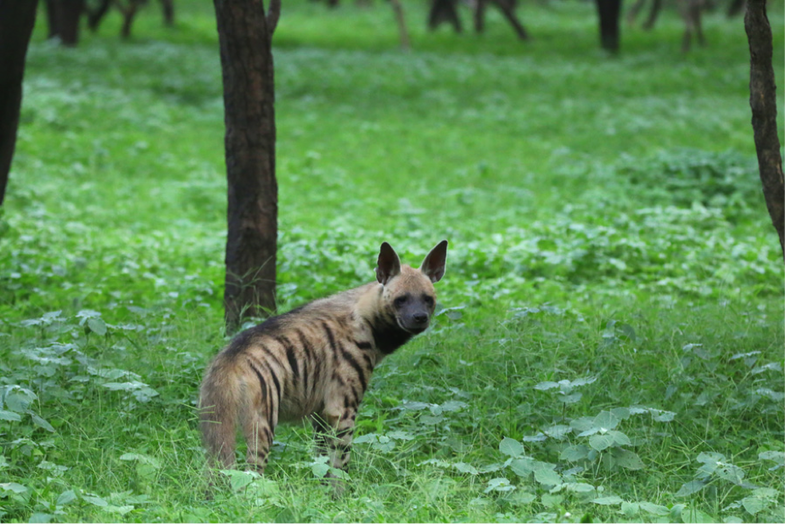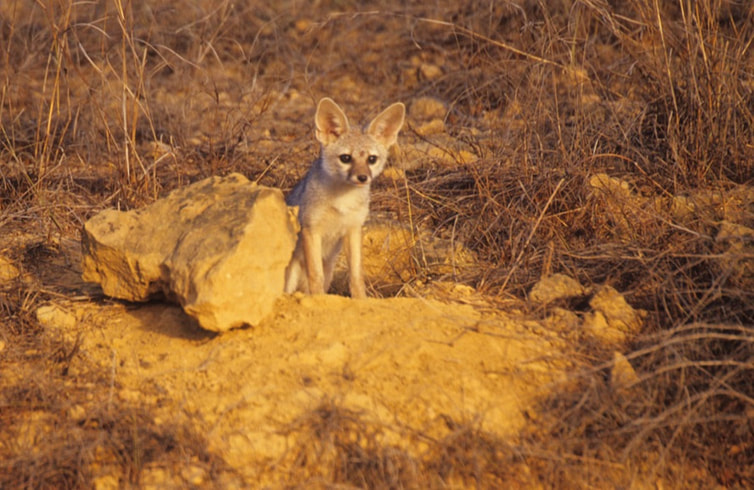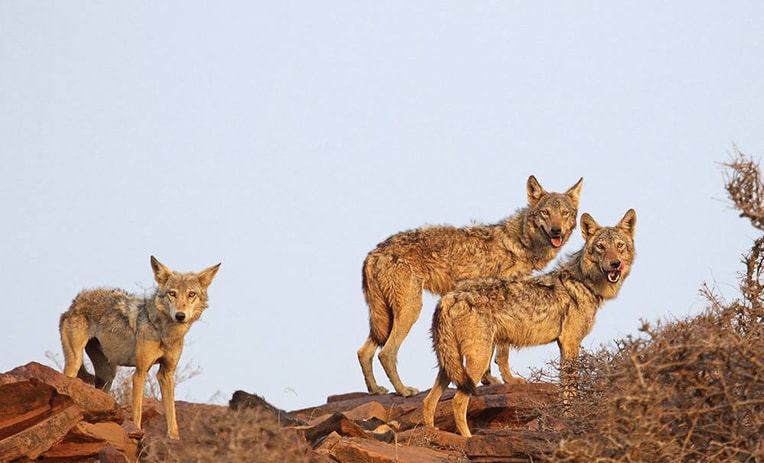|
Soham Chakraborty To see a striped hyena in the wild is always a challenging task. Hyenas are nocturnal and highly elusive. In 2018, I was doing my research on dietary patterns of leopards in Jhalana Leopard Conservation Reserve, Rajasthan. Jhalana is India’s first leopard conservation reserve. With an area of around 30 sq. km, Jhalana is rich in biodiversity with a healthy population of leopards. Other than leopards, striped hyenas and desert foxes also thrive the reserve. Before commencing my research work I had visited this place a few times but wasn’t lucky enough to get the glimpse of a striped hyena. I started my research work from mid-May when the forest is dry and has greater visibility. On my very first day, after an excellent sighting of a leopard I had my first striped hyena sighting. I fall short of adjectives to describe that moment. The hyena was resting near a water hole, hardly bothered by the 3–4 gypsys around it. It was the first time that I was able to photo-document it. I had seen a hyena crossing the road in Rajaji National Park earlier that year. But that was during night time and I could not photograph the animal. After the first day’s sighting in Jhalana, hyena sightings became a regular event. A subsequent sighting which would be hard to forget was during the monsoons, when the forest becomes lush green with thick canopy. It is a little more difficult to spot animals during this season. Although leopard sightings were frequent, the same can’t be said in case of striped hyenas. After searching for nearly 2 hours in evening, we had hardly seen anything. There were no herbviore alarm calls to suggest presence of leopards. So I told my driver to wait near a water hole till dawn arrives. It was at this moment that I saw a gypsy standing 200 metres away from us and the tourists clicking pictures one after the other. Upon reaching the location I realised it was a hyena. The grey body with black stripes amidst a lush green background was simply amazing. It is probably the best sighting I have had of a hyena till date.
1 Comment
Arjun Srivathsa There was the usual hustle-bustle in Rampura camp that cold February morning. Five researchers and fifteen local assistants were getting ready for fieldwork in Bandipur National Park. The placid morning vibe was broken by a loud and audibly painful call of an animal. I ran outside, out through the room and across the yard to the edge of the trench that hemmed the camp area. A pack of dholes –the ‘Rampura pack’– was pursuing something in the Lantana bushes on the other side of the path, at about 30 meters from us. I tried counting the dogs with great difficulty as they ran around haphazardly. The eight members had managed to bring down a medium-sized Chital doe and were presently devouring it. With blood-smeared muzzles, they ran around in a kind of finicky fashion. A cacophony of snarls, yip-yaps and short whistles formed a part of their breakfast conversation. Every now and then, two of them would get into a little spat. But soon this would resolve and they would continue carving layers off the ungulate. One of them, perhaps the sentinel, would repeatedly jump out of the huddle, run across the path and with ears pushed back and tail held erect – make a whistling noise at the bushes. After a few minutes three or four of the individuals strenuously dragged the carcass to a smaller path that ran perpendicular to the one where they were currently feasting. The rest of them hopped and ran around creating an illusion of the pack being larger than it in fact was. I waited for them to move out of view and then slowly inched towards the junction of the two paths. The vegetation on either side of the path was dense. They had abandoned the carcass in the middle of the path. I wondered for a bit if I had spooked them off. My wonderment was broken when three or four of them would make quick visits to the carcass to tear off parts of the flesh and scoot into the bushes. This continued for about six to seven minutes, and soon enough there was almost nothing left of the doe. Slowly and quietly, barefooted, I made my way to the place where I last saw them disappear. I crouched low hoping to catch a glimpse of them through the thorny Lantana thicket. They sat scattered in a pile amidst some bones and insignificant remains of the doe. They seemed indifferent to my presence. They ran around playfully with one or more of them stopping to giving me a cock-eyed stare every few seconds.
It had already been around half an hour since I was tracking the activities of the Rampura pack. I left them in peace and headed camp-wards. “Today will be a good day”, I said to myself. It already was. Chandrima Home It was a chilly December in 2004 when I landed up in a “heritage village”–Tera– in Kachchh, about 90 km away from Bhuj, Gujarat. I was studying resource-use by Indian foxes in this landscape as a part of my Masters dissertation. My initial field days started with looking around for fox dens with Vilji Bhai, a member of the Koli tribe (a hunting tribe) who had a remarkable sharpness to detect animals. Once an active den was identified, I would find a suitable place about 200–300 meters away and observe the den site from dawn to dusk. Since it was the breeding season, foxes actively used dens for raising their young. One of the den sites in Kakribet was ideally located amidst small hillocks. I positioned myself atop a hillock with a spotting scope, a bag full of field supplies and a flashlight. The field station coordinator was instructed to pick me up by 6 pm since my teammates were heading off for a vulture survey and would be late. Contrary to my expectations, the level of activity at the den was minimal. The fox went for a short stroll and once back, it did not venture out from the den. As dusk approached, there was still no sign of the vehicle to pick me up. Through the curtain of darkness, all that I could see were the silhouettes of hillocks and acacia trees around me. I tried to find my way out using my flashlight, but realized that the beam was not powerful enough. As soon as the sun went down, the mercury dipped and the only thing that made me anxious was I may not be adequately equipped with warm clothes. But there was nothing much that could be done since the vehicle that was supposed to pick me up had still not arrived. I convinced myself that Kachchh was safe since there are no large carnivores (except the Indian wolf, which was a rare sighting). As darkness descended, the landscape came alive. I could distinctly hear mating calls of foxes. This was intermittently broken by faint dog howls from faraway villages. At 9:30 pm it was pitch dark, and there was still no sign of the vehicle. A rustle in the leaves close by made my senses taut. The movement drew closer and after sometime I felt heavy breathing sounds around me. It was as if someone was sniffing me! I sat there, not moving an inch and trying not to breath. The rustling stopped and after a few minutes of eerie silence came a train of deafening howls. It was a group of jackals (may be 4 to 5 of them) that had come to inspect me. They were perhaps within 5 to 10 meters away when they all decided to howl. After some time the rustling died down and I presumed that the jackals had moved on.
I was eventually picked up around midnight. Though my body was numb with cold, my mind was racing with the fascinating acoustic experience! For the next couple of months in field, I observed jackals to be extremely wary of humans. My closest encounters have been at least 50 meters away. That night was the closest I could see (or rather hear) them, and perhaps the closest I have been to jackals in all these years. Priya Ranganathan Dusk was settling over the grey waters of the Chambal. The sky, which had been clear and bright up until thirty minutes ago, was now settling into deeper shades of blue and purple. As my field assistant would say, the hunting hour was fast approaching. He was talking, of course, about the Indian wolf. It was in these ravine systems where I had a rather nerve-wracking encounter with wolves. It began when our driver deserted us in the ravines. The jeep was cranky and old and refused to traverse the narrow sandy ridges. So he stopped the jeep and told us to go along the transects. My field assistant and I walked for over an hour through a system of confusing ravines, marking GPS points, marking scats, pellets, signs, and pugmarks. We eventually found ourselves on a sandy bank with the Chambal river sprawled out before us. That was when I noticed the pugmarks by the water, right where we were standing. “Wolves,” I said, nudging my field assistant. He came over to look. “We should call the driver,” he said nervously. Wolves do not have a positive reputation with many of the local tribes in this region. Pacing along the riverbank, I looked up at the darkening ravines looming above us and made a decision- to retrace our steps to where we left the jeep. My field assistant was less than pleased. Retracing your steps with a nervous field assistant continuously muttering about bad omens in your ear is hard. “Madam, are we lost?” my assistant asked feebly, when I stopped and puzzled. That was when the howls began. My assistant couldn’t help the shriek that left his mouth as the eerie howling of wolves was picked up by two, three, five, six animals, seemingly surrounding the gorge where we stood. My eyes struggled to acclimatize to the shadowy darkness. I heard rustling from above, where the low sandy cliffs nearly met over our heads and tried to slow the thumping of my heart. The howls grew in volume and intensity. My assistant suggested we play loud music and sing along! “The wolves will hear the songs and think we are a large group of people. They will stay away from us.” I was already worried about finding our way back to the jeep, so I gave in. Singing along to racy Hindi songs while running away from wolf hunting grounds was definitely not part of my internship contract. It was when I looked up at the dark sloping ravines above us that I saw their glowing eyes. We were intruders in their habitat, but they were keeping a distance from the cacophony we were causing. After that first glimpse of the wolves, I kept a lookout for more of those elusive canids. After half an hour of wandering blindly through wolf country, we heard faint shouts and saw flashing lights. My teammate and the driver had found us! The howls of the wolves faded away, and as we reunited with our teammates, I looked back at the shadowy ravines from where I had emerged.
The wolves had vanished, melting back into the shadows. All that was left were pugmarks and the echoes of howls in the night wind above the Chambal. |




 RSS Feed
RSS Feed
